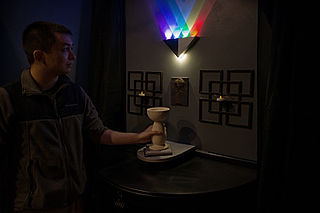
Spot the difference is a type of puzzle where players must find a set number of differences between two otherwise similar images.

Spot the difference is a type of puzzle where players must find a set number of differences between two otherwise similar images.
Spot the difference games are found in various media including activity books for children, newspapers, and video games. They are a type of puzzle where players must find a set number of differences between two otherwise similar images, whether they are illustrations or photographs that have been altered with photo manipulation.
Visual comparison may be used to solve the puzzle. The solution to the puzzle is often listed nearby or in an accompanying answer page of a puzzle book. Additionally, one can cross one's eyes and merge the two pictures into one, in the much the same way as when viewing an autostereogram picture. The differences will appear to blink in and out of one's vision. This is a very effective method of solving these puzzles.

A way to solve a spot the difference puzzle digitally is to create a inverse version of one of the images to compare and to overlay it 50% on the other one.[ clarification needed ]

Derived from the Greek word for '5', and "domino", a pentomino is a polyomino of order 5; that is, a polygon in the plane made of 5 equal-sized squares connected edge to edge. When rotations and reflections are not considered to be distinct shapes, there are 12 different free pentominoes. When reflections are considered distinct, there are 18 one-sided pentominoes. When rotations are also considered distinct, there are 63 fixed pentominoes.

Puzzle video games make up a broad genre of video games that emphasize puzzle solving. The types of puzzles can test problem-solving skills, including logic, pattern recognition, sequence solving, spatial recognition, and word completion. Many puzzle games involve a real-time element and require quick thinking, such as Tetris (1985) and Lemmings (1991).
In computational complexity theory, a decision problem is PSPACE-complete if it can be solved using an amount of memory that is polynomial in the input length and if every other problem that can be solved in polynomial space can be transformed to it in polynomial time. The problems that are PSPACE-complete can be thought of as the hardest problems in PSPACE, the class of decision problems solvable in polynomial space, because a solution to any one such problem could easily be used to solve any other problem in PSPACE.

A cryptic crossword is a crossword puzzle in which each clue is a word puzzle. Cryptic crosswords are particularly popular in the United Kingdom, where they originated, as well as Ireland, Israel, the Netherlands, and in several Commonwealth nations, including Australia, Canada, India, Kenya, Malta, New Zealand, and South Africa. Compilers of cryptic crosswords are commonly called "setters" in the UK and "constructors" in the US. Particularly in the UK, a distinction may be made between cryptics and "quick" crosswords, and sometimes two sets of clues are given for a single puzzle grid.

Nonograms, also known as Hanjie, Paint by Numbers, Picross, Griddlers, and Pic-a-Pix are picture logic puzzles in which cells in a grid must be colored or left blank according to numbers at the edges of the grid to reveal a hidden picture. In this puzzle, the numbers are a form of discrete tomography that measures how many unbroken lines of filled-in squares there are in any given row or column. For example, a clue of "4 8 3" would mean there are sets of four, eight, and three filled squares, in that order, with at least one blank square between successive sets.

Rubik's Magic, like the Rubik's Cube, is a mechanical puzzle invented by Ernő Rubik and first manufactured by Matchbox in the mid-1980s.
Mathematical puzzles make up an integral part of recreational mathematics. They have specific rules, but they do not usually involve competition between two or more players. Instead, to solve such a puzzle, the solver must find a solution that satisfies the given conditions. Mathematical puzzles require mathematics to solve them. Logic puzzles are a common type of mathematical puzzle.

Kakuro or Kakkuro or Kakoro is a kind of logic puzzle that is often referred to as a mathematical transliteration of the crossword. Kakuro puzzles are regular features in many math-and-logic puzzle publications across the world. In 1966, Canadian Jacob E. Funk, an employee of Dell Magazines, came up with the original English name Cross Sums and other names such as Cross Addition have also been used, but the Japanese name Kakuro, abbreviation of Japanese kasan kurosu, seems to have gained general acceptance and the puzzles appear to be titled this way now in most publications. The popularity of Kakuro in Japan is immense, second only to Sudoku among Nikoli's famed logic-puzzle offerings.
A programming game is a video game that incorporates elements of computer programming, enabling the player to direct otherwise autonomous units within the game to follow commands in a domain-specific programming language, often represented as a visual language to simplify the programming metaphor. Programming games broadly fall into two areas: single-player games where the programming elements either make up part of or the whole of a puzzle game, and multiplayer games where the player's automated program is pitted against other players' programs.

Nurikabe is a binary determination puzzle named for Nurikabe, an invisible wall in Japanese folklore that blocks roads and delays foot travel. Nurikabe was apparently invented and named by Nikoli; other names for the puzzle include Cell Structure and Islands in the Stream.

Induction puzzles are logic puzzles, which are examples of multi-agent reasoning, where the solution evolves along with the principle of induction.
Games World of Puzzles is an American games and puzzle magazine. Originally the merger of two other puzzle magazines spun off from its parent publication Games magazine in the early 1990s, Games World of Puzzles was reunited with Games in October 2014.

Slitherlink is a logic puzzle developed by publisher Nikoli.

An escape room video game, also known as escape the room, room escape, or escape game, is a subgenre of point-and-click adventure game which requires a player to escape from imprisonment by exploiting their surroundings. The room usually consists of a locked door, objects to manipulate, and hidden clues or secret compartments. The player must use the objects to interact with other items in the room to reveal a way to escape. Escape the room games were born out of freeware browser games created in Adobe Flash, but have since become most popular as mobile games for iOS and Android. Some examples include Crimson Room, Viridian Room, MOTAS, and Droom. The popularity of these online games has led to the development of real-life escape rooms all around the world.

Pandora's Box is a 1999 video game created by Alexey Pajitnov for Microsoft.
QuickSpot is a video game for the Nintendo DS developed by Namco Bandai. The game is designed similar to games such as Brain Age which uses simple brain teaser to exercise reflexes and brain function. It is a part of Nintendo's Touch! Generations brand and is the first in the Unō no Tatsujin series. A sequel, titled titled Unou no Tatsujin Soukai! Machigai Museum 2, was released exclusively in Japan on March 1, 2007. An updated and renewed version of the game, titled QuickSpot: Master of the Right Brain, was developed by Bandai Namco Studios and published by Bandai Namco Entertainment for Nintendo Switch. It was released on April 22, 2021 in Japan and on January 6, 2022 in the west.

Hellnight, known as Dark Messiah in Japan, is a first-person survival horror video game developed by Dennou Eizou Seisakusho and published by Atlus Co. in collaboration with Konami in 1998. The game is an adventure game with 3D.

Grudge Warriors is a car combat video game released by Take-Two Interactive on April 27, 2000. The game retailed for the low price of $9.99, a response by Take-Two to the recent decision of Sony to drop PlayStation licensing fees. Similar to the earlier PlayStation title Twisted Metal, players control a powerful tank-like armored vehicle, which they used to destroy enemy vehicles, weapons, and generators, solve puzzles, and collect tokens to upgrade their weapons. There are a total of twenty-three missions, and the game allows two players to battle each other in split screen multiplayer.

Indiana Jones in the Lost Kingdom is a puzzle video game developed by Michael J. Hanson and published by Mindscape for the Commodore 64. The game is based on the Indiana Jones series, and it was released in North America in late 1984. In the UK, the game was imported and distributed by U.S. Gold.

Big Brain Academy is a series of puzzle video games developed and published by Nintendo. Similar to the Brain Age series, each game features a number of activities designed to test, measure, and improve the player's mental skills. The first two games were released under the Touch! Generations brand, which has since been discontinued.